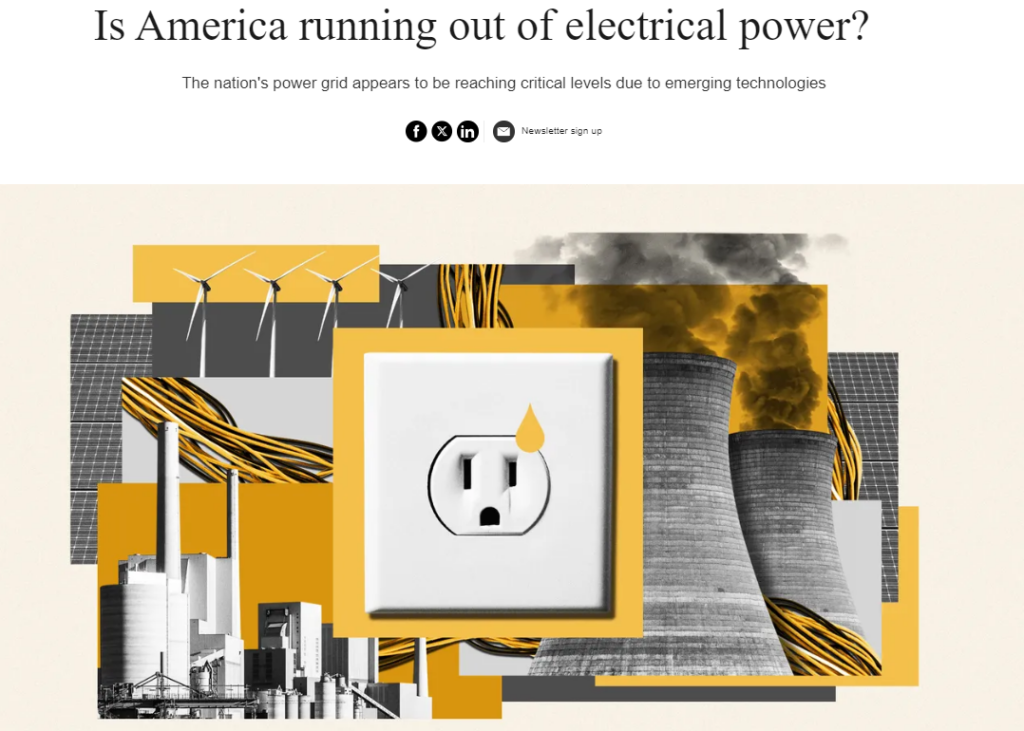Power outages were also predicted for America but this time, climate change is not the sole issue which is to be blamed. The advancement of new technologies was added as a culprit as well. Can you see the trend and where will all this take the masses?
This is what The Week reported last March:
“The advancement of new technologies appears to have given rise to a new problem across the United States: a crippling power shortage on the horizon. The advent of these technologies, such as eco-friendly factories and data centers, has renewed concerns that America could run out of electrical power.
These worries also come at a time when the United States’ aging power grid is in desperate need of repair. Heavily publicized incidents such as the 2021 Texas power outage, which was partially blamed on crypto-farming, exposed how vulnerable the nation’s power supply is, especially during emergencies. There have also been warnings from tech moguls such as Elon Musk, who has stated that the United States is primed to run out of electricity and transformers for artificial intelligence in 2025.
But the push to extend the life of the nation’s power grid, while also maintaining eco-friendly sustainability, begs the question: Is the United States really at risk of going dark?
What did the commentators say?
The emergence of new technologies means demand is soaring for power across the country; in Georgia, ‘demand for industrial power is surging to record highs, with the projection of electricity use for the next decade now 17 times what it was only recently,’ Evan Halper said for The Washington Post. Northern Virginia ‘needs the equivalent of several large nuclear power plants to serve all [its] new data centers,’ Halper said, while Texas faces a similar problem.
This demand is resulting in a ‘scramble to try to squeeze more juice out of an aging power grid.’ At the same time, companies are ‘pushing commercial customers to go to extraordinary lengths to lock down energy sources, such as building their own power plants,’ Halper said.
Much of this relates to the ‘rapid innovation in artificial intelligence, which is driving the construction of large warehouses of computing infrastructure,’ Halper said. This infrastructure requires significantly more power than traditional data centers, with the aforementioned crypto farms also sucking up massive amounts of power.
Climate change is also hurting sustainability efforts. A recent report from the North American Electric Reliability Corporation estimated that more than 300 million people in the U.S. and Canada could face power shortages in 2024. It also found that electricity demand is rising faster now than at any time in the past five years. This is partially because the ‘push for the electrification of heating and transportation systems — including electric cars — is also creating new winter peaks in electricity demand,’ Jeremy Hsu said for New Scientist.
One of the main issues with these sustainability efforts is the push to move away from fossil fuels toward renewable power. Natural gas is often seen as a bridge between fossils and renewables, but this has also had unintended consequences for the power grid. The system delivering natural gas ‘doesn’t have to meet the same reliability standards as the electric grid, and in many cases, there’s no real way to guarantee that fuel is available for the gas plants in the winter,’ Thomas Rutigliano of the Natural Resources Defense Council said to New Scientist.
As a result, the ‘North American electricity supply has become practically inseparable from the natural gas supply chain,’ John Moura of the North American Electric Reliability Corporation said to New Scientist. As such, a ‘reliable electricity supply that lowers the risk of power outages depends on implementing reliability standards for the natural gas industry moving forward,’ but this may be easier said than done.
What next?
When it comes to the year-round power efforts, there have been some positive signs. In 2023, the American power grid “quietly survived its most brutal summer yet,” Vox said, and “despite record power demand, the grid largely avoided blackouts.” This fact is ‘even more remarkable’ when considering that ‘July 2023 was the hottest month on the planet since at least 1880,’ Vox said. However, this doesn’t mean that summer blackouts in subsequent years are not on the way.
And the winter months are still telling a different story, as the problems with the power grid will likely continue as technology keeps advancing. Climate change will also continue to play a factor in crippling the power supply; Last month, at least 800,000 people in California were without power after severe flooding, winds and mudslides devastated the region, a climate trend that doesn’t appear to be going away.”

